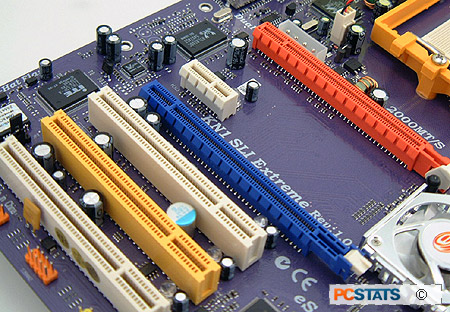 Remarkably, the KN1-SLI Extreme
motherboard utilizes a switchless SLI setup. From the assortment of motherboards
we've seen, generally only super high end motherboards support switch-less SLI.
If ECS can implement this on the KN1-SLI Extreme, there really is no excuse for
other manufacturers not to do the same. During testing this feature functioned
flawlessly and beat our best attempts to confuse the motherboard with various
videocard combinations.
Remarkably, the KN1-SLI Extreme
motherboard utilizes a switchless SLI setup. From the assortment of motherboards
we've seen, generally only super high end motherboards support switch-less SLI.
If ECS can implement this on the KN1-SLI Extreme, there really is no excuse for
other manufacturers not to do the same. During testing this feature functioned
flawlessly and beat our best attempts to confuse the motherboard with various
videocard combinations.
The extra space between the two PCI Express x16 slots
on the KN1-SLI Extreme is also a nice touch. The extra breathing room just makes it
easier to install larger heatsinks or waterblocks on videocards.
Right above the first PCI Express x16 slot is a molex
power connector set onto the motherboard. This power connector is recommended for when two high powered videocards are run in SLI. It's
not absolutely necessary with 7800GTX-class videocards (which is what we tested with), and the system did not
experience any problems running in our tests without the extra power.
The ECS KN1-SLI Extreme is not the first motherboard we have tested that
supports external Serial ATA devices but it is the first to adhere to the eSATA
standard. Previous motherboards allowed for external connectivity of internal
SATA devices; whereas the KN1-SLI Extreme supports the official External Serial
ATA cable connection standard.
 Originally designed as
an internal bus, developers quickly ported SATA over for external use since
there is so much bandwidth available. eSATA's main benefit over
competitors like USB 2.0 or IEEE 1394a is that eSATA is up to six times faster. Cables can be as much
as two meters in length, and eSATA is natively supported by all Serial ATA
controllers.
Originally designed as
an internal bus, developers quickly ported SATA over for external use since
there is so much bandwidth available. eSATA's main benefit over
competitors like USB 2.0 or IEEE 1394a is that eSATA is up to six times faster. Cables can be as much
as two meters in length, and eSATA is natively supported by all Serial ATA
controllers.
eSATA and SATA connectors and cables are not compatible with each other;
this is to prevent users from using unshielded internal cables for
external use. To prevent ESD damage, the internal contact depth has been
increased from 5mm to 6.6mm and the contacts themselves are placed further
back. Unfortunately we do not have any eSATA devices around the labs, otherwise
we would have tested this feature... Still it is nice to see
ECS incorporate a new standard now so that users will be good to go should they adopt eSATA
devices in the future.
Rear I/O Exhaust Fan
 Round
back, the I/O ports consist of a pair of network jacks (one 10/100, the other
GbE), the audio jacks, SP/DIF and in place of where the parallel port
traditionally goes, a fan exhaust. The bright green plastic air scoop and 40mm
fan are intended to quickly remove some of the hot air generated by the socket
939 AMD Athlon64 processor and power MOSFETs from the case, thereby lowering
overall internal temperatures.
Round
back, the I/O ports consist of a pair of network jacks (one 10/100, the other
GbE), the audio jacks, SP/DIF and in place of where the parallel port
traditionally goes, a fan exhaust. The bright green plastic air scoop and 40mm
fan are intended to quickly remove some of the hot air generated by the socket
939 AMD Athlon64 processor and power MOSFETs from the case, thereby lowering
overall internal temperatures.
The concept is good, but we're left wondering why the
I/O shield is still just cut for a parallel port? A real vent for this exhaust
fan should have been incorporated in to the I/O plate. In any case, the fan is
40mm fan (which is replaceable) is very quiet and does a decent job at
expelling hot air from the system.
ECS has come up with a novel way of protecting end users
from the experience of a bad BIOS flash. Rather than mounting two BIOS chips on
the motherboard itself, a second BIOS is supplied in a specialized double-sided
BIOS socket.  ECS call this backup solution the "Top-Hat" flash module.
ECS call this backup solution the "Top-Hat" flash module.
Since the surface mounted BIOS ROM contacts
are exposed on the actual motherboard, the backup ECS "Top-Hat" flash module can
simply be clipped into place on top of the board mounted BIOS chip when
needed.
Should there be a bad BIOS flash, the ECS
Top-Hat flash module will take over from the onboard BIOS, and once the board is
up and running take off the Top-Hat device and proceed to re-flash your
motherboard. The process is very simple and it works quite well, just make sure
you keep the Top-Hat module in a safe spot that you will remember!
The brand of capacitors we find on the ECS
KN1-SLI Extreme motherboard are OST, G.LUXON and a brand only identified with a
capital M as its logo.
